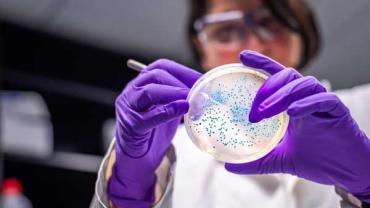
You can’t pick up a medical journal these days without coming across articles about the body’s microbiome. Whether it’s in the gut, the skin, the mouth, the vagina, or even the eyes (yes—the eyes have a microbiome!), the microbes that inhabit our bodies appear to play a role in health and disease. The various biomes in different parts of the body have become hot topics in biomedical and nutrition research, but a recent study brings to light an important issue: much of the research on the gut biome, specifically, has been conducted in mice. And the murine gut biome may be more different from that of humans than we realized.
The study was conducted at California Institute of Technology (Caltech) and published—no surprise—in the journal Microbiome. Researchers sought to investigate changes in the upper GI tract biome that occur as a result of fecal microbial self-reinoculation via coprophagy.” In plain English: how is the biome of the proximal GI tract affected when mice eat their own poop? Considering this is something we humans don’t do, if this behavior has a profound effect on the composition of the gut biome, it could have implications for our understanding of numerous different aspects of diet and health.
Lead study author Said Bogatyrev, MD, PhD, noted, “One area could be dietary research. If you have more microbes in the small intestine, that, in turn affects the bile-acid composition there and the nutrients in the diet may be absorbed differently. Fats, for example.”
Drug research is another field that could be profoundly impacted by differences in murine and human gut microbiomes. Rodents are often the animals selected for use in preclinical models. Drugs that are absorbed in the small intestine may have somewhat different metabolisms and pharmacokinetics in humans than they do in mice. Of course, this is taken into account and safety is rigorously tested before drugs are approved for use in humans and released onto the market, but it’s still worth acknowledging that preliminary data gathered from rodent studies may be less applicable or reproducible in humans than we previously thought.
So what did the Caltech researchers actually do? They outfitted mice with devices that prevented them from consuming their own feces so they could compare these non-coprophagic mice with standard mice. Specifically, they were looking to evaluate the effects of this “self-reinoculation” on microbial loads, composition, and function in the upper GI tract.
They found that compared to standard mice, mice that were prevented from coprophagy had substantially lower bacterial loads in the upper GI tract and the composition of the bacteria was dramatically different as well. The researchers wrote, “These differences in microbial abundance and community composition were associated with an altered profile of the small intestine bile acid pool, and, importantly, could not be inferred from analyzing large intestine or stool samples.” This is noteworthy because much of what is known about the human intestinal microbiome is based on stool samples or biopsies of the large intestine, in part because sampling from the small intestine is much more difficult and more invasive. Apparently, however, even though the real estate is in adjacent neighborhoods, the microbial populations of the small and large intestines may be very different.
The patterns observed in the non-coprophagic mice—decreased total upper GI microbial load, low abundance of anaerobic microbes, and bile acids predominantly in the conjugated form—are similar to those seen in the small intestines of healthy humans. In contrast, those that engaged in coprophagy had upper GI microbiomes that more closely resembled those of humans with microbial overgrowth disorders, such as small intestinal bacterial overgrowth (SIBO).
Dr. Said pointed out that there’s a lot yet to be uncovered about the potential impacts of these findings on what we believe about the effects of various interventions on health outcomes: “Although there’s a recognition that self-reinoculation with fecal flora and metabolites may be an issue and it may affect some study outcomes, we just don’t know yet how important it is. This work suggests that the effects of self-reinoculation need to be rigorously tested, which provides a plethora of opportunities for future research.”
One thing we do know right now is that antibiotics have a major adverse impact on the gut biome. These are lifesaving drugs and should be respected as such, but over-prescription (as well as patient over-reliance on them) has contributed to the resistant “superbugs” that plague us now. Moreover, “antibiotic-induced microbiota alterations can remain after long periods of time, spanning months and even years.” One study showed that a single 10-day course of an antibiotic could induce changes in fecal or salivary microbiomes that persist for as long as four months to a year. The microbiome may be more resilient in some individuals than others, and diet likely plays a role in microbial diversity. Consumption of certain foods or supplements may aid in restoration of a healthy microbial balance.